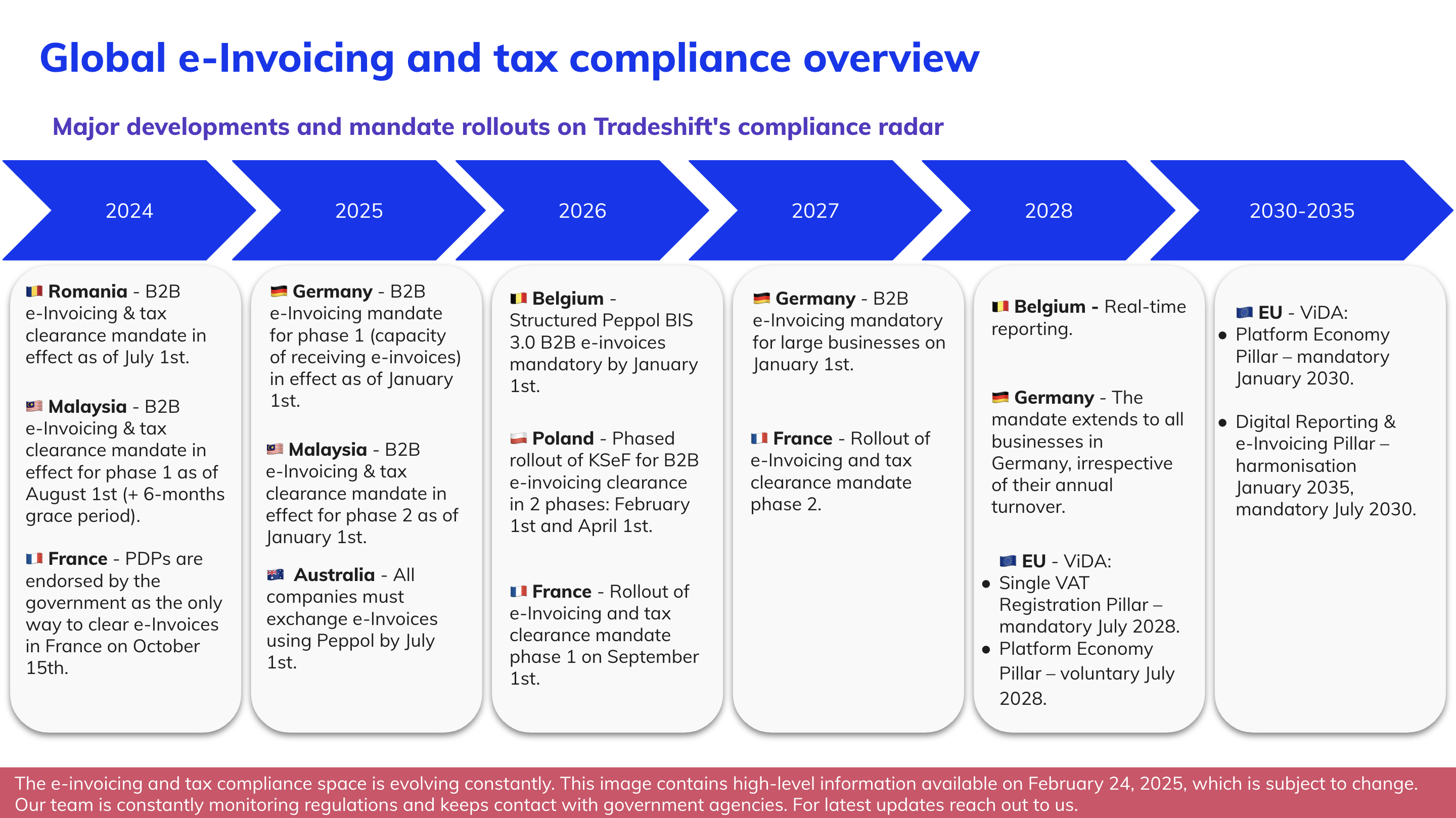E-Invoicing and tax compliance in the next 5 years
The future of e-Invoicing and tax compliance: what to expect in the next 5 years
By Ioana Ploesteanu, Product Marketing Manager, Tradeshift
E-Invoicing is here to stay
The global shift toward e-Invoicing compliance and real-time tax reporting has been one of the most significant regulatory developments in recent years.
In 2024, several countries rolled out their own mandates, including Germany’s e-Invoicing compliance framework, Romania and Malaysia’s tax clearance systems, and France’s phased implementation of mandatory e-Invoicing through designated technology providers. At the EU level, the ViDA (VAT in the Digital Age) initiative mandates that by 2030, all member states must adopt e-Invoicing and digital reporting.
As we look ahead, the next five years will bring further digital transformation in e-Invoicing and tax compliance, requiring businesses to adapt their strategies and budgets accordingly. This article explores the evolving global landscape of e-Invoicing, upcoming regulatory trends, and how businesses can prepare for the future.
The global context for e-Invoicing and tax compliance
Governments worldwide are increasingly mandating e-Invoicing and real-time tax clearance systems to combat fraud, improve tax collection efficiency, and streamline business transactions. Some key developments include:
- Europe: Even though currently each country has their own e-Invoicing compliance requirements, the EU’s ViDA initiative, adopted by the EU Council on March 11th 2025, will drive standardization across member states, pushing businesses to transition from paper-based invoices to fully digital, government-cleared invoicing systems.
- Asia-Pacific: Countries such as Malaysia, India, and South Korea have implemented tax clearance models requiring businesses to report invoices in real time to tax authorities.
- Americas: Brazil and Mexico have long-established e-Invoicing frameworks, and the U.S. is seeing increased discussions about adopting similar standards.
- Middle East & Africa: The UAE and Saudi Arabia have introduced structured e-Invoicing mandates, with more countries expected to follow suit.
This growing momentum means businesses operating across multiple jurisdictions must stay agile and compliant with varying regulatory frameworks.
What to expect in the next 5 years
1. Global standardization of e-Invoicing frameworks
As more countries implement e-Invoicing compliance, there will be a push toward interoperability. The EU’s ViDA framework will influence other regions to harmonize their e-Invoicing models, reducing complexity for multinational businesses.
2. Increased adoption of real-time tax clearance systems
Governments are shifting from post-transaction reporting to real-time tax clearance, requiring businesses to submit invoices for approval before issuing them to customers. Countries such as France and Romania have already moved in this direction, and more will follow.

3. AI and automation in tax compliance
Tax authorities are leveraging artificial intelligence to detect fraud and improve tax collection efficiency. Businesses will increasingly rely on AI-driven compliance solutions to automate invoice validation, tax reporting, and fraud prevention.
4. Stricter penalties for non-compliance
As tax authorities tighten regulations, penalties for non-compliance will become more severe. Businesses that fail to adapt may face fines, operational disruptions, or reputational damage.
5. Growth of technology providers for seamless compliance
With the complexity of e-Invoicing mandates, businesses will increasingly turn to specialized technology providers like Tradeshift. These providers offer seamless integration with government systems, ensuring compliance while simplifying workflows.
Preparing for the future: how businesses can stay ahead
1. Assess current compliance readiness
Businesses must conduct a thorough assessment of their invoicing and tax compliance processes to identify gaps and align with emerging regulations.
2. Invest in scalable e-Invoicing solutions
Selecting a robust e-Invoicing platform that supports multi-country compliance and integrates with existing ERP systems will be critical for long-term success.

3. Stay informed on regulatory changes
As tax laws continue to evolve, organizations should monitor developments and engage with regulatory experts to ensure ongoing compliance.
4. Train finance and IT teams
Ensuring that finance, IT, and AP teams are well-versed in e-Invoicing compliance and are technology savvy will facilitate smoother transitions and reduce risks of non-compliance.
5. Partner with a technology provider
Working with a specialized e-Invoicing provider simplifies compliance by automating tax clearance processes and ensuring seamless integration with government platforms.
The road ahead: embracing digital transformation
E-Invoicing compliance and tax clearance mandates are reshaping how businesses operate globally. Over the next five years, we will see increased standardization, real-time reporting requirements, and a stronger reliance on automation. Companies that proactively embrace digital transformation and invest in compliance-ready solutions will not only avoid penalties but also gain operational efficiencies. Now is the time to strategize and future-proof your business for the next era of e-Invoicing.
Penalties for non-compliance are increasing. Is your business compliant?
You may also be interested in
e-Invoicing compliance: what to look for when selecting a partner
As e-Invoicing mandates and Continuous Transaction Controls (CTC) become the global standard, choosing the right e-invoicing compliance partner is essential for seamless compliance. Learn how to stay ahead of regulations.
Mastering e-Invoicing mandates: How AP and AR alignment drives success
For global organisations operating across multiple jurisdictions, the
significant differences in how e-Invoicing mandates are implemented from one country to another further increase the complexity. This is making the already demanding role of an accounts payable (AP) and accounts receivable (AR) leader even harder.
Why your ERP needs Tradeshift to do AP right
When handling supplier invoices, chances are that you may still have more manual work than necessary. While a robust ERP system integrates various business functions to record and store information, it struggles to address the most common challenges that leave accounts payable (AP) teams bogged down in inefficient and error-prone manual processes. This is where AP automation software like Tradeshift comes in.
Enabling global tax compliance
How to streamline tax compliance domestically and for cross-border document transactions. Transitioning from paper to electronic invoices (e-invoices) involves one process for complying with B2B e-invoicing mandates using locally compliant document formats, while a separate process is required to ensure tax compliance. Add to the mix the document transactions between suppliers (e-invoice senders) and buyers (e-invoice receivers) from different countries, and you have the recipe for a very complex process.



